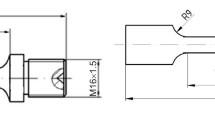Abstract
A specimen, called the ring specimen, was developed to determine the fracture toughnessK tc, under conditions of autofrettage. Tests were carried out on standard arc shaped specimens and ring specimens without autofrettage to obtainK tc values of a gun barrel steel chosen for study and seen to yield similar results. Tests were also performed on autofrettaged (100 percent overstrain) ring specimens at various crack lengths producing results with a dramatic decrease inK tc of 60 per cent. From this, it may be inferred that the critical length of a crack in an autofrettaged gun barrel made of this material will be less than anticipated. Although cold work or autofrettage enhances fatigue life by decreasing crack propagation rate, it is seen to decreaseK tc creating, from this point of view, more dangerous conditions. For a design which must guarantee long life, the accompanying decrease in critical crack size may indeed prove a liability. Of course, this is a result for one particular material with a specific heat treatment and therefore not general; other materials must be tested, as well.
Résumé
On a étudié une éprouvette, dénommée éprouvette en anneau, en vue de déterminer la ténacité à la ruptureK tc sous des conditions d'auto-frettage. Des essais ont été effectués sur des éprouvettes standards en forme d'arc et sur des éprouvettes en anneau sans auto-frettage en vue d'obtenir les valeurs deK tc dans le cas d'un acier pour âme de canon choisi pour l'étude. Ces essais ont conduit à des résultats similaires. Des essais ont également été effectués sur des échantillons en anneau auto-frettés à 100% de sur-dilatation correspondant à diverses longueurs de fissure. Les résultats ont montré une diminution deK tc de l'ordre de 60%. On peut déduire de cette observation que la longueur critique relative à une fissure dans une âme d'un canon auto-fretté réalisé dans ce matériau sera plus faible que prévu. Bien que l'écrouissage où l'auto-frettage améliore l'endurance en fatigue par des croissances de la vitesse de propagation d'une fissure, on constate qu'elle diminue leK tc, occasionnant de ce point de vue des conditions plus dangereuses. Dans le cas d'une construction qui doit garantir un service de longue durée, la décroissance de la dimension critique d'une fissure peut être pénalisante. Bien entendu, ceci n'est qu'un résultat pour un matériau particulier avec un traitement thermique spécifique, qui dès lors ne peut être généralisé. D'autres matériaux doivent être également testés.
Similar content being viewed by others
References
“Standard Test Method for Plane-Strain Fracture Toughness of Metallic Materials E 399-83”,1986 Annual Book of ASTM Standards, Vol. 03.01, American Society for Testing and Materials, Philadelphia, Pa(1986) 522–557.
W.H. Cathey and A.F. Grandt, Jr.,Journal of Engineering Materials and Technology, 102 (1980) 85–91.
A.P. Parker, J.H. Underwood, J.F. Throop and C.P. Andrasic, inASTM-STP 791, American Society for Testing and Materials, Philadelphia, Pa (1983) I–216-I–237.
W. Prager and P.G. Hodge, Jr.,Theory of Perfectly Plastic Solids, John Wiley and Sons, New York, USA (1951) 95–121.
C.P. Andrasic, personal communication.
A.F. Grandt, Jr.,International Journal of Fracture 14 (1978) R221-R229.
A.P. Parker and C.P. Andrasic, inASTM-STP 833, American Society for Testing and Materials, Philadelphia, Pa (1984) 57–71.
I. Marmur, “Influence of the Autofrettage Process on Fracture Toughness of a Gun Barrel Steel”, M.Sc. thesis, Tel Aviv University, (in Hebrew) (1988).
W.F. Brown, Jr. and J.E. Srawley,ASTM-STP 410, American Society for Testing and Materials, Philadelphia, Pa (1966) 1–65.
M.H. Jones and W.F. Brown, Jr., inASTM-STP 463, American Society for Testing and Materials, Philadelphia, Pa (1970) 63–101.
Author information
Authors and Affiliations
Rights and permissions
About this article
Cite this article
Banks-Sills, L., Marmur, I. Influence of autofrettage on fracture toughness. Int J Fract 40, 143–155 (1989). https://doi.org/10.1007/BF00963972
Received:
Accepted:
Issue Date:
DOI: https://doi.org/10.1007/BF00963972




